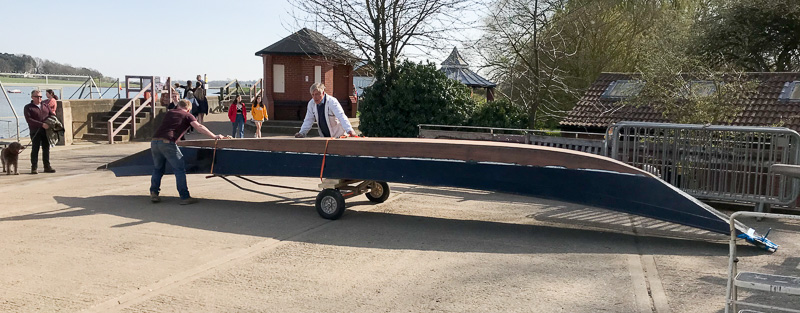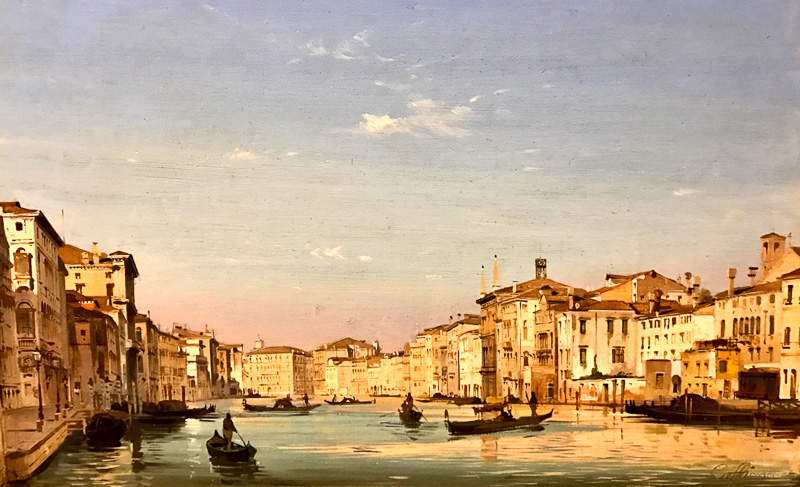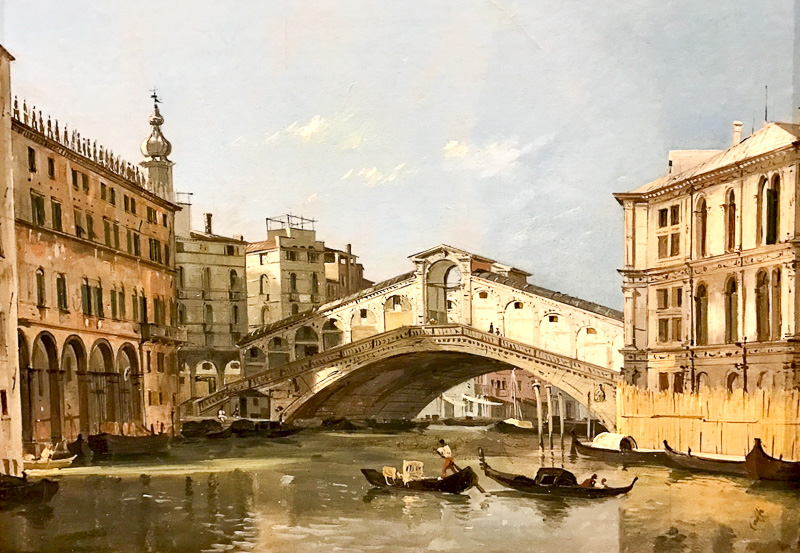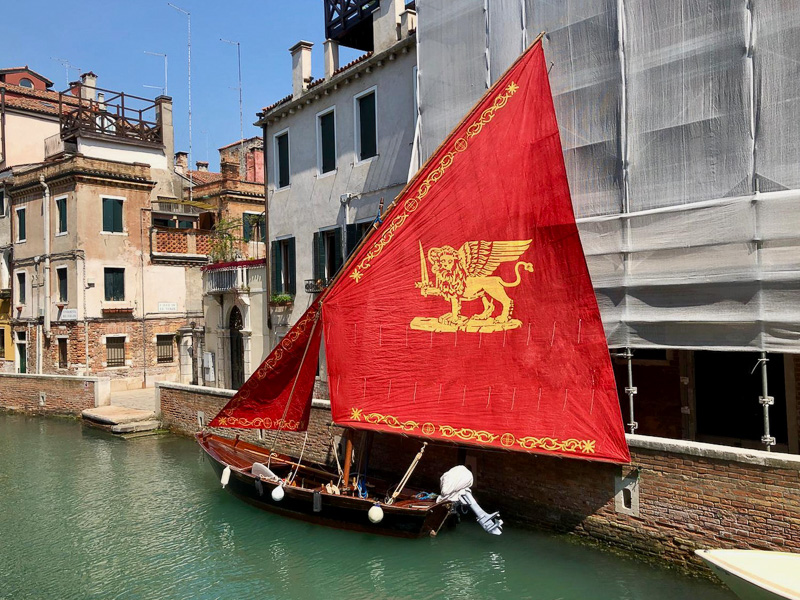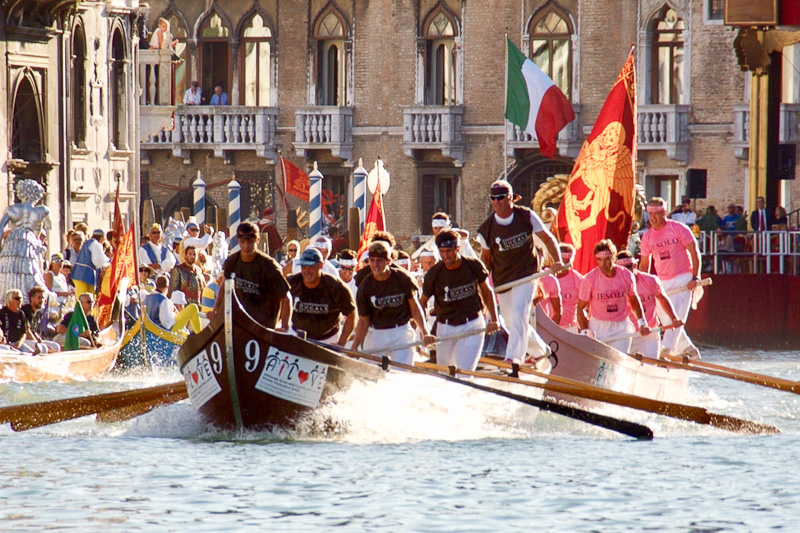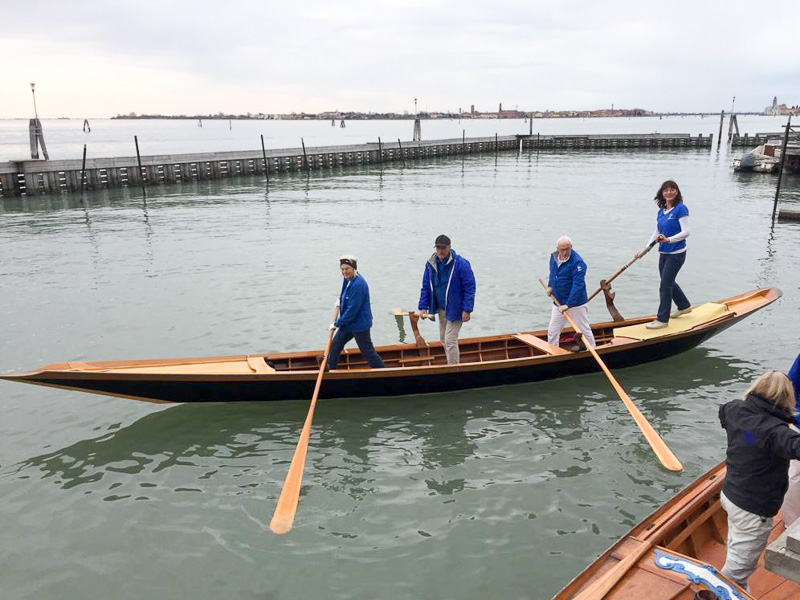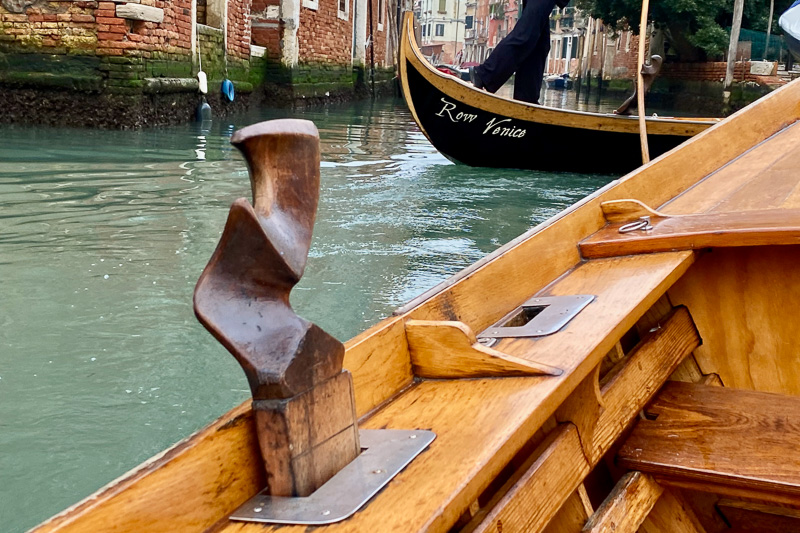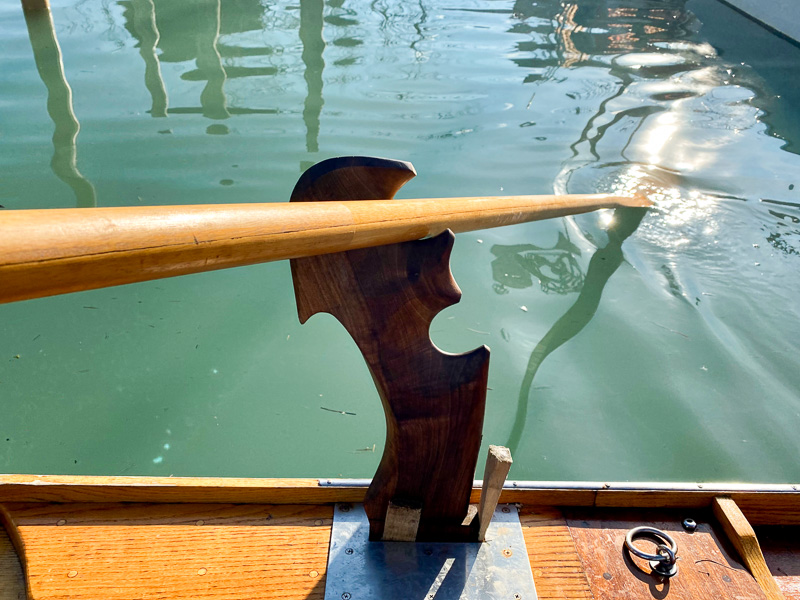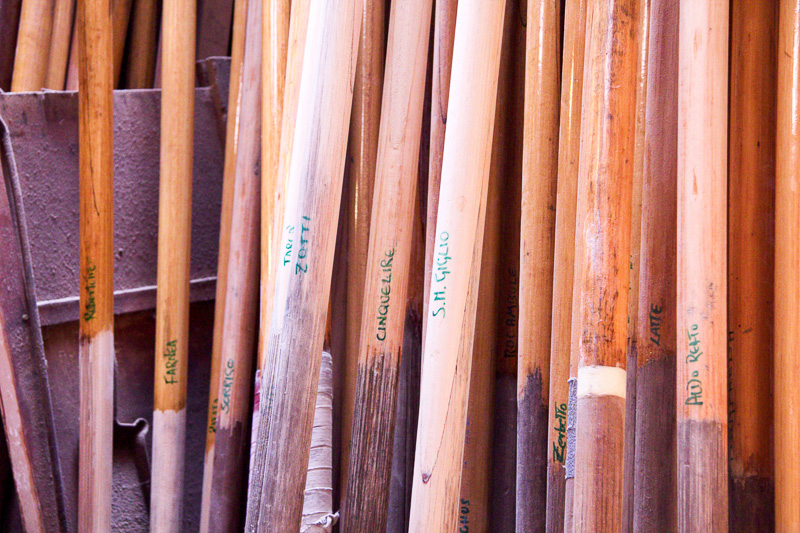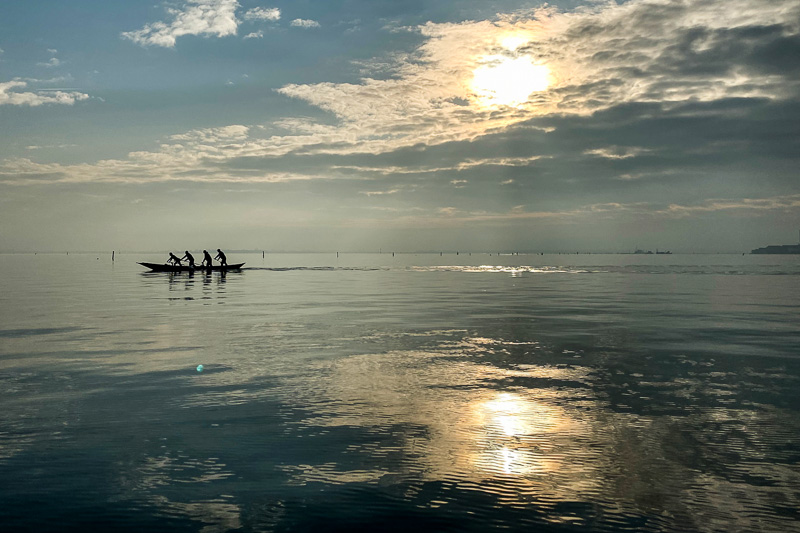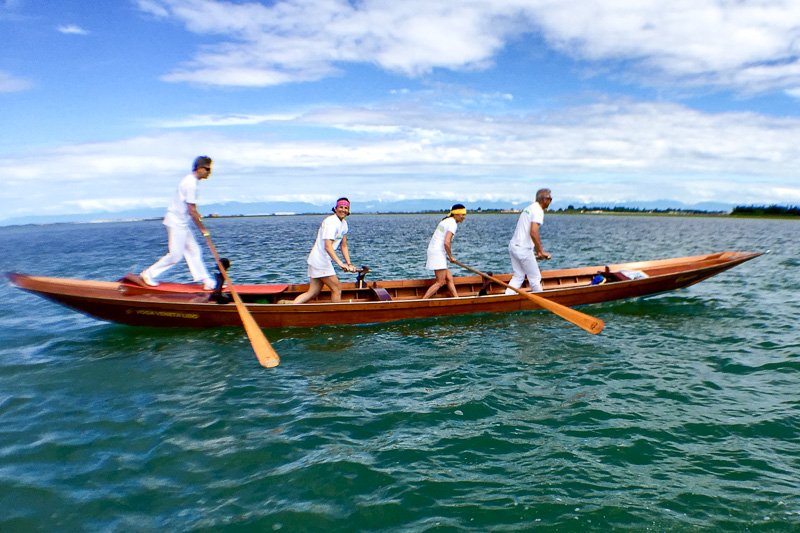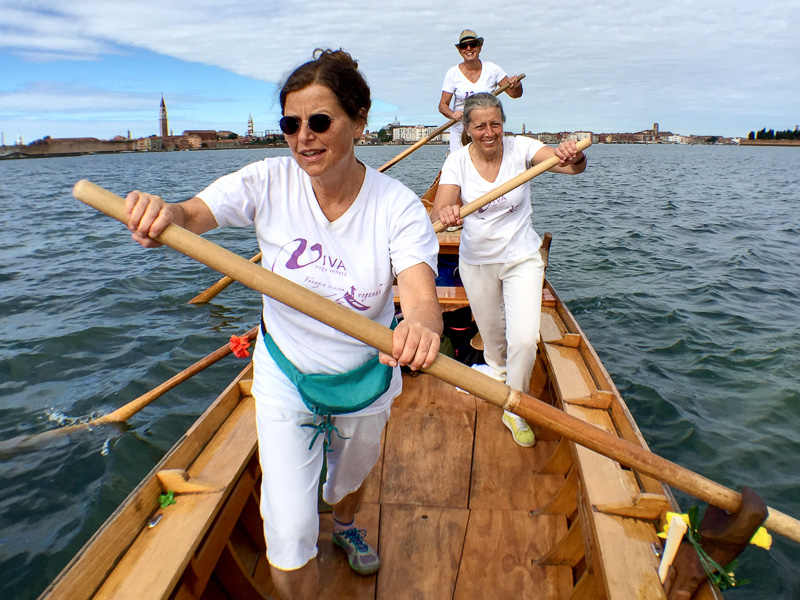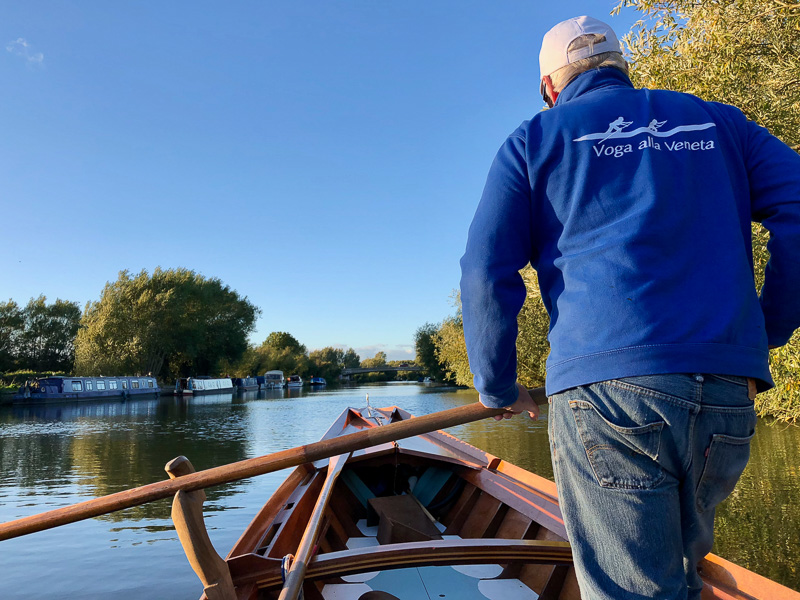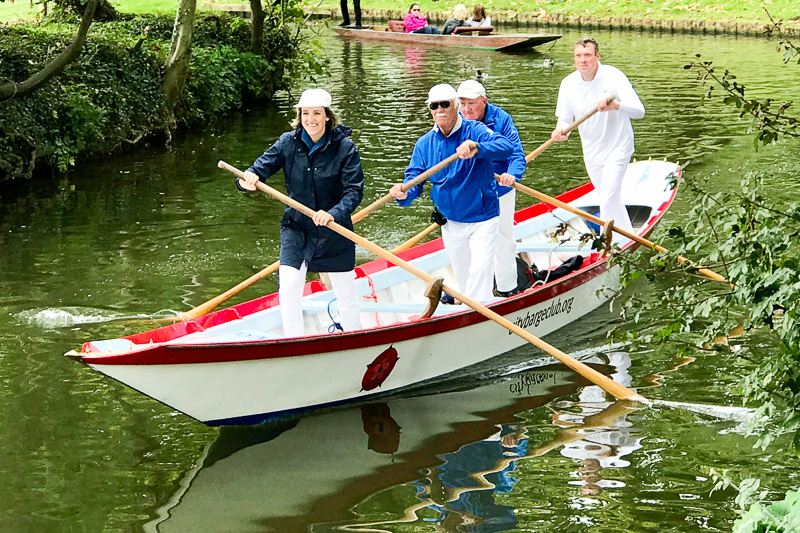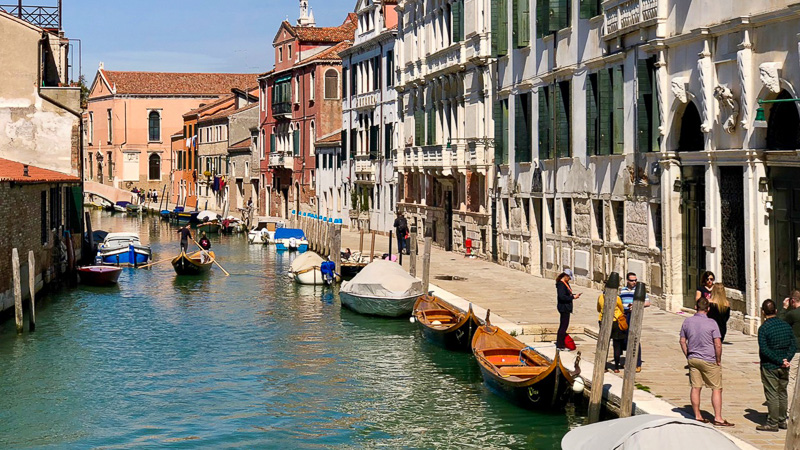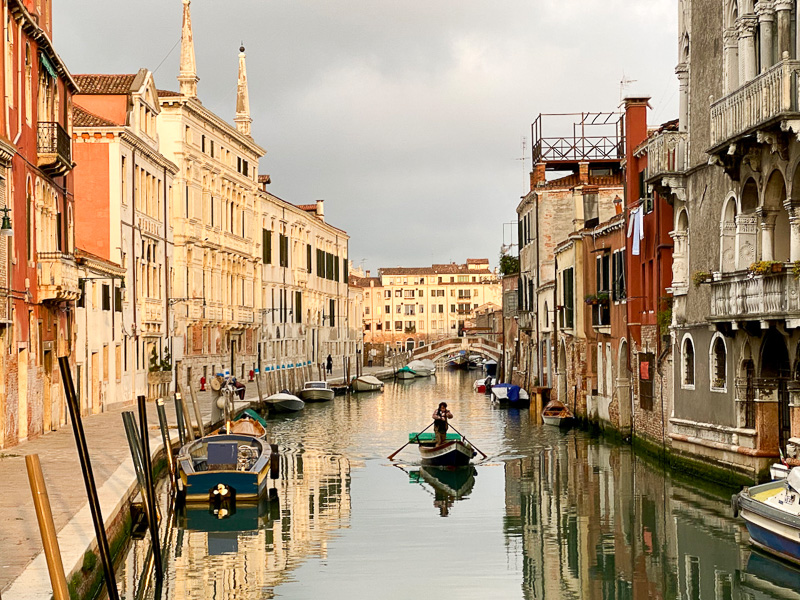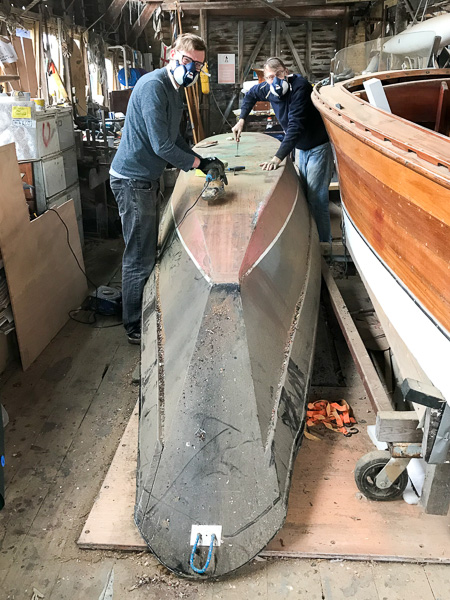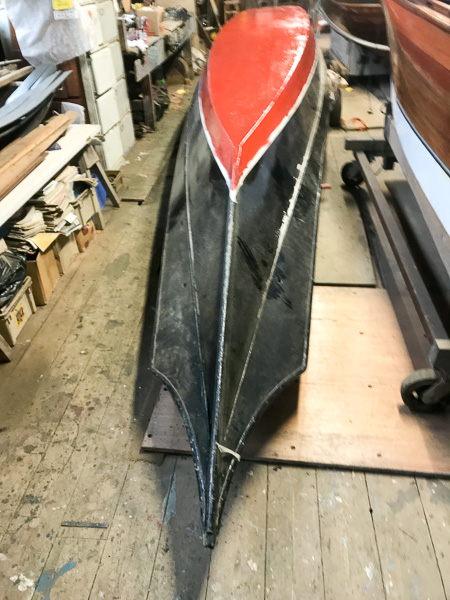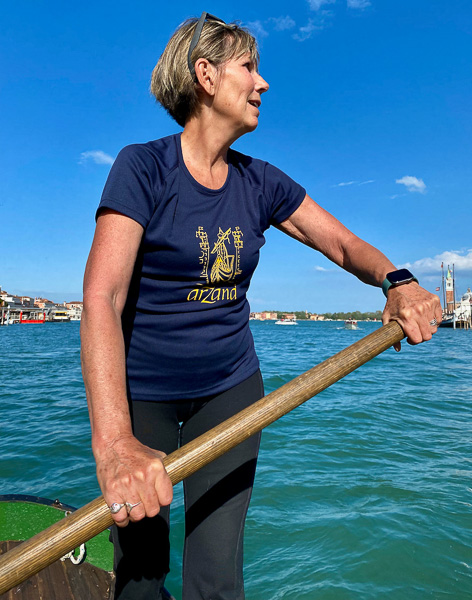by Nan McElroy
If you’re a devotee of Woodbridge boatyard and the River Deben, you may have spotted Eric and Maxine Reynolds manoeuvring a particularly unfamiliar, curious-looking traditional craft towards the end of 2020. It’s wood, of course, but awfully skinny, and perhaps ten metres long with minimal draft. It’s outfitted with long, flat wooden oars, but no rigging. What is it, exactly? Where’d it come from? When will we see it again? And how, exactly, does it work?
This charming and fascinating vessel is a Venetian pupparino, one of the more than 50 types of traditional Venetian boats that once served as the city’s primary means of transport from its inception until the mid 1950s. Imported direct-from-Venezia by Maxine last year, Marco will be traversing the River Deben from now on, very likely enticing locals’ curiosity about Venetian rowing as well. That’s right: standing up, facing forward, just like a gondolier.
Recounts Maxine, ‘When Eric bought Woodbridge Boatyard, I realised I wouldn’t be seeing much of him in Venice. I looked at the Deben and thought, perhaps…? I do love rowing with Eric, so I imported Marco from our family home in Venice to Woodbridge. There’s been so much interest since it arrived, we’re now looking for ways to introduce this magnificent Venetian boat and rowing style to local wooden boat enthusiasts’.

Boat Yard Manager, Matt’s, first Venetian rowing lesson
Beyond the Gondola
Most of us are familiar with the silhouette of the iconic gondola; even a brief ride seems almost obligatory for any visitor to Venice today. Not so in the days of the Republic, however. These opulent craft were not for hire, but the exclusive private transport of the patrician class, replacing carriages and drivers or limousines and chauffeurs employed everywhere else.
If you peruse any of the historical Venetian water-scape paintings by Canaletto, Carpaccio or Caffi however, along with the gondola you’ll spot a host of other types of Venetian craft, each with their own purpose: fishing, cargo transport, and more. So where are those boats now?
With the advent of private motor transportation after the end of WWII, both traditional Venetian boats—along with their unique rowing style—began to disappear slowly from their lagoon home. After all, if you were still rowing as everyone else was becoming motorized, it would have been the equivalent to holding on to your horses once the motorcar was the norm. Fortunately, as rowing evolved away from a means of transport and into a sport and leisure activity, a few types of these traditional craft populate the Venetian waters still today. [1]
- the sandolo, the structural template for all Venetian boats, versatile, stable and perfect for beginning rowers
- the graceful mascareta, once used by masked courtesans, is today a principal racing boat for women
- the San Pierota is the spacious, versatile and extremely popular latecomer that you can row, motor, or sail
- the ancient workhorse caorlina was born in Caorle and fished the Adriatic and the Venetian lagoons for centuries. It may be sailed with an added rudder or propelled by up to six rowers, as you’ll see it in the Regata Storica
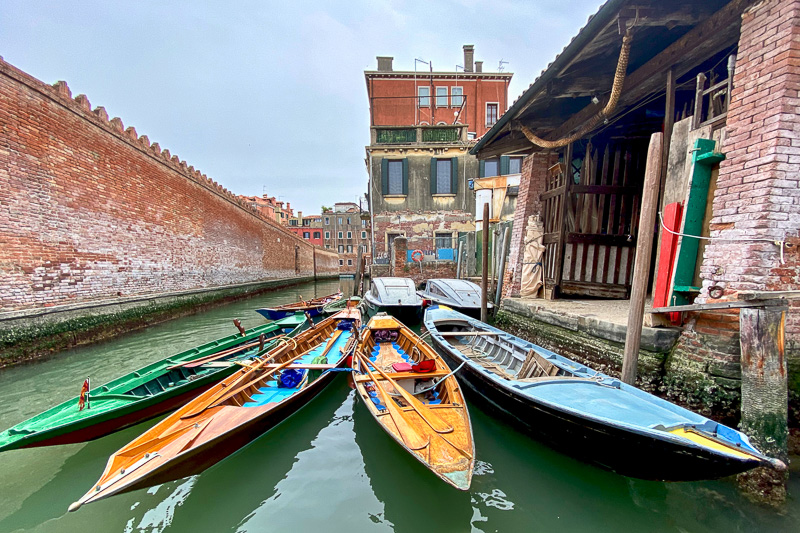
Traditional Venetian boats moored outside Arzanà
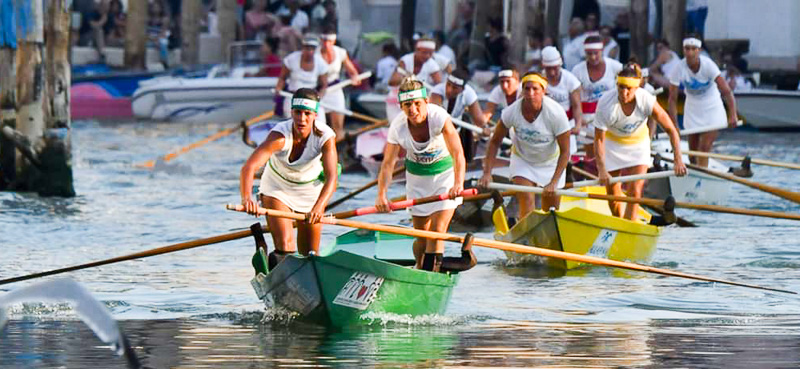
Regata Storica – Mascareta. Photo: Marco Sabadin
And Marco? The puparin (Venetians can’t be bothered with double letters or final syllables) is one of the most refined and technically perfect of Venetian boats. As the traditional boat association describes it: ‘Initially created for maritime surveillance use, over the years—thanks to its elegant, asymmetric shape and that it can be easily rowed with an oar—like the gondola it acquired the status of “casada boat”, the term for private craft that were used by the Venetian patrician families for their transit about town’. [2]
Today, the puparìn is most prominent in Venetian regate: it’s rowed single-oared by women and youth in the Murano regatta, by a crew of two women in Burano and men in the San Giovanni e Paolo regatta, and by youth in the most famous of Venetian races, the Regata Storica.
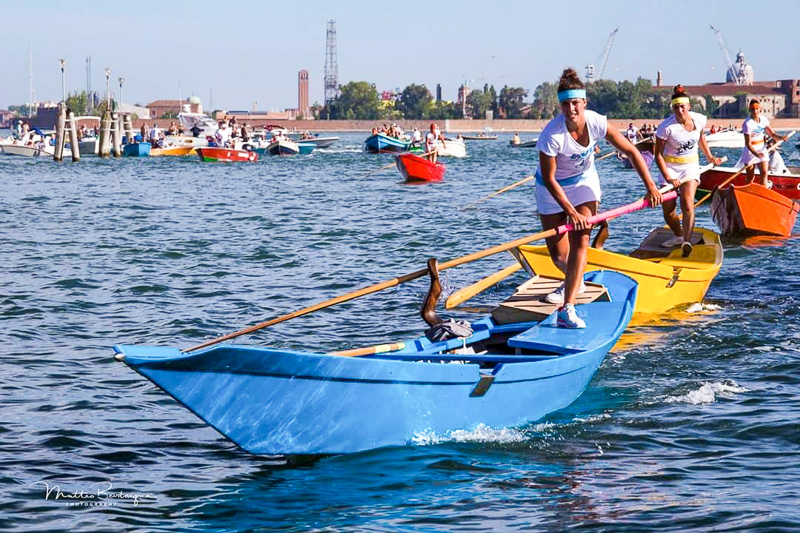
Elisa in the Regata di Murano, pupparino one oar. Photo: Matteo Bevilacqua
MEET MARVELOUS MARCO
Pupparino Marco is a true ‘signore’ with quite a storia, beginning with its construction by master boat builders Pietro & Guido Amadi on Burano over 45 years ago. ‘It’s extremely fast,’ says Maxine. ‘I’ve been told by roughly five different Venetians that it was built for two brothers and won the first Vogalonga’. Marco later belonged to artist Nick Blair-Fish [3], owner of the historic Ca’ MalCanton [4], from whom Eric and Maxine acquired it. Why this boat? ‘Eric likes competitive rowing,’ says Maxine. ‘Plus, it’s a great boat for picnic outings with friends and family. Loungers can lie back and take in the scenery while the curious can have a go at rowing themselves.’
The name pupparino references the stern, or popa, which is raised like that of a gondola, and allows for greater oar leverage, propulsion, and thus, speed. Marco’s construction is in larch, marine plywood and mahogany, and its asymmetric form facilitates keeping the boat on a straight course when rowing with one oar: there is less need to correct the boat direction on the return stroke.
And speaking of oars and oarlocks, remi e forcole—they both have a number of characteristics particular to Venetian vessels. Both are all-wood and hand-crafted by artisanal woodwrights, or remer in Venetian. Rollocks are hewn from massive blocks of aged hardwood, like cherry or walnut (Marco’s are walnut). And as you’ll notice, Venetian forcole do not ‘lock’ at all: the smooth, curved notch enables removal of the oar at any moment, for a manoeuvre or when threading a narrow canal.
The wood used in the hewing of the over three-metre long oars will depend instead on the type of boat, preference of the rower, and wood availability: beech for a more flexible oar, for example, ash or ramino for a more rigid one, or a combination. In addition, a Venetian oar blade is not cupped: as the return stroke serves as a rudder to navigate the boat, the oar must feather easily back through the water.
Beyond that, oars and rollocks are specifically crafted for the type of boat, the position in the boat, and in the case of a private vessel, the individual rower. All serious rowers are utterly devoted to their preferred remer. (Show them a boat, oar, or oarlock, and they will tell you who crafted it.)
Marco’s oars and oarlocks were custom-made for its owners by two trusted Venetian remer. Lorenzo Gambirasi, known far and wide for his forcole, began carving them under his father Gigio for their Santa Fosca boat rental, or fita batee fleet. Many rowers wouldn’t think of having an oar made by anyone other than Renato dal Mistro, or Chinica as he was known in his uber-successful racing days. Renato garnered flags in 10 out of the 14 Regate Storica in which he competed, with five first-place finishes in the Burano regattas. Renato, whose workshop is handily located just across the canal from Maxine and Eric’s garden, crafted Marco’s beautiful oars.
Row your Venetian Boat
The fortunate thing for Venetian traditional boat enthusiasts is that all Venetian craft—gondole, pupparini, sandoli and the rest—are rowed exactly the same way. If you can row a sandolo, you can row a gondola. Okay, with a little practice…
The attraction of the voga alla veneta, or Venetian rowing style is that the oar is propelled less with brute force, and more with the weight and the momentum of your forward body movement. ‘We row with our heads,’ goes the Venetian saying, ‘not with our backsides’.
So how do you learn? If you grow up in Venice, you might learn from your parents, or a rowing club, a friend, or other more-recently established organizations that offer lessons for beginners [5]. If you’re Maxine and Eric, you just ‘buy boats, put them in the water and watch everybody else’.
In all fairness, however, Eric might have had a leg-up on his autodidactic approach. He’s a Freeman of The Worshipful Company of Watermen and Lightermen, and a loyal member of Vesta Rowing Club in Putney since 1959. He’s also a trustee of Gloriana, the Queen’s Rowbarge and the Royal Museums Greenwich. ‘He jolly well ought to be able to get from A to B in a boat,’ quips Maxine. She deserves some points as well. Her prior experience with boats prior to Venetian ones? ‘Zero’, she confirms. ‘A very kind gentleman spotted us and offered a 15-minute lesson in Venetian. Though we think we understood most of it, we’ll never know if he approved as never saw him again.’
If you can walk, however, you can row Venetian style. It’s the same motion, but as you step, you propel your weight over your front leg and onto the oar handle and subsequently, row the boat. There is oar rotation and technique-refining for an efficient stroke, as you might imagine…but you get the drift. (Maxine points out that this is a form of exercise that often appeals to older age groups as it is so close to walking.)
Try your hand
In 2020, Maxine, along with Venice resident and Row Venice co-coordinator Nan McElroy (who went the lesson route to learn), were hoping to offer ‘taster’ sessions in Woodbridge as part of the Woodbridge Regatta in 2020. As soon as travel and social conditions permit, they aim to pick up where they left off, and Taster sessions will be available as part of events celebrating life on the Deben River in 2021. Watch out for local announcements.
While you’re waiting for the Taster in Woodbridge, you might want to get in touch with the City Barge Boat Club in Oxford [6], the only Venetian rowing club in England. They offer taster sessions as well as occasional Open Days created specifically for newcomers to Venetian rowing, but are always happy to hear from anyone interested in knowing more.
And if you’ll be visiting Venice, be sure to reserve a private lesson with Row Venice [5] in their rare batele a coda di gambero, the shrimp-tailed batela. In fact, Row Venice founder, racer and expert Jane Caporal’s private batela was constructed by the same Amadi brothers of pupparino Marco fame—it’s a small Venetian rowing world.
In any case, whether in the Woodbridge Boat Yard’s Pheonix Works shed or on the River Deben, be sure to keep an eye out for pupparino Marco. We are sure this extraordinary craft will inspire your curiosity for both traditional Venetian boats, and the unique, elegant way they are rowed.
And to answer the question at the beginning – Marco will be back on the Deben from this weekend (May 15th 2021) thanks very largely to the volunteer help given by Clive and Charlton Bannister.
Nan McElroy
Nan McElroy builds websites, writes, takes photographs, edits video, and frankly tastes lots of wine since she became an AIS sommelier in 2009. She learned to row Venetian style shortly after she relocated to Venezia in 2004, and is now a coordinator and rowing instructor at Row Venice, which offers Venetian rowing lessons for travelers.
@livingvenice on Facebook and Instagram
References and for more on Traditional Venetian Boats and Rowing:
[1] Associazione Arzanà: For the Study and Conservation of Venetian boats.
- Gondola Examples.
- Request a visit to their unique collection of traditional boats and their implement.
[2] Arzanà’s encyclopedic archive
[3] Artist Nick Blair-Fish
[4] Owner of the historic Ca’ MalCanton
[5] RowVenice.org: Venetian rowing lessons in Venice, on-site training on request.
[6] City Barge Boat Club, Oxford: the only Venetian rowing club in England
[7] Associazione Settemari: Local Venetian rowing club
[8] Mare di Carta, your one-stop nautical bookshop in Venice and on the web. For publications on traditional Venetian boats, look for books by Luigi Divari and Gilberto Penzo.

